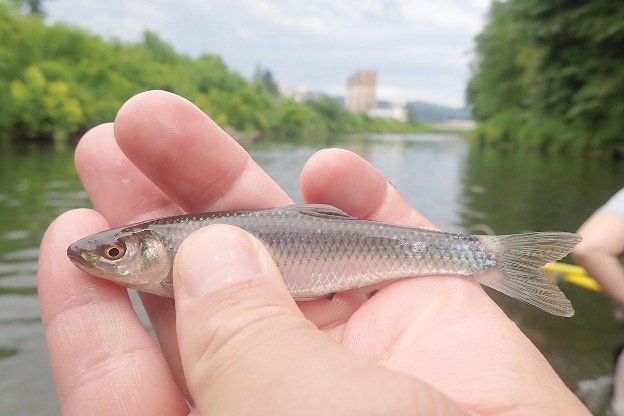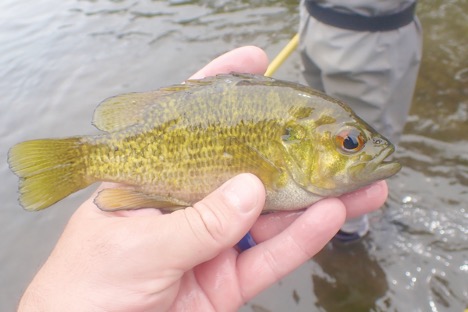Written by Holly Kays, Smoky Mountain News, Waynesville, NC, Wednesday, August 02, 2023
When the impending closure of Canton’s paper mill was announced in March, conservation professionals predicted a swift improvement in downstream water quality once papermaking stopped.
A Whitetail Shiner caught during sampling is held up with the mill in the background. NCWRC photo.
After a recent round of fish sampling, Luke Etchison, the western region aquatic wildlife diversity coordinator for the N.C. Wildlife Resources Commission’s Inland Fisheries Division, is surprised to see just how quickly that recovery is unfolding. “So far it’s hard to believe how much of a difference there’s been,” he said.
In late July, the Wildlife Commission sampled fish populations at three sites downstream from the mill — just below it at Blackwell Drive, midway between Clyde and Canton, and at the Charles Street bridge in Clyde. When they sampled the same three sites in May, before paper production ceased, they observed 14 species between the three sites, and 157 total fish. July’s sampling yielded double the diversity and a 15-fold increase in fish found — 28 different species and 2,626 fish.
Rock Bass, which had been absent during May sampling conducted before the mill closure, was found at all three downstream sites in July. NCWRC photo
Perhaps the most startling results came from the site between Clyde and Canton, where 13 fish representing seven species were found in May. In July, biologists counted 16 species and 831 individual fish. Of those, 644 were Silver Shiners. While there might normally be some seasonal variation between May and July observations, a doubling of species diversity is unheard of, Etchison said.
The team found nine Olive Darters at Blackwell Drive, tying the record in their database for the most found at one time — typically, when the species is present, only one or two are seen at a time. At a site located between Canton and Clyde, there were five Mottled Sculpin, a coolwater fish species that seems to be heading into the area now that the mill is no longer keeping the water unnaturally warm.
At both the Canton and Clyde sites, a single Brown Trout was observed. This is an encouraging sign, but even so, the river is unlikely to become a trout fishery. The habitat might be good enough for a few trout to survive temporarily, but it’s too warm for them to reproduce and survive the warmest summer weather, Etchison said. However, the team did observe juvenile Smallmouth Bass, which is a good sign for bass anglers.
Overall, there was “an absolute ton” of juveniles from a variety of species. Before carrying out the sampling, Etchison had assumed that improvements to reproduction wouldn’t be observed until next year.
To read the entire story and for additional information on the fish populations in the Pigeon River, please go to: https://smokymountainnews.com/outdoors/item/36105-hard-to-believe-downstream-fish-populations-explode-following-mill-closure.

